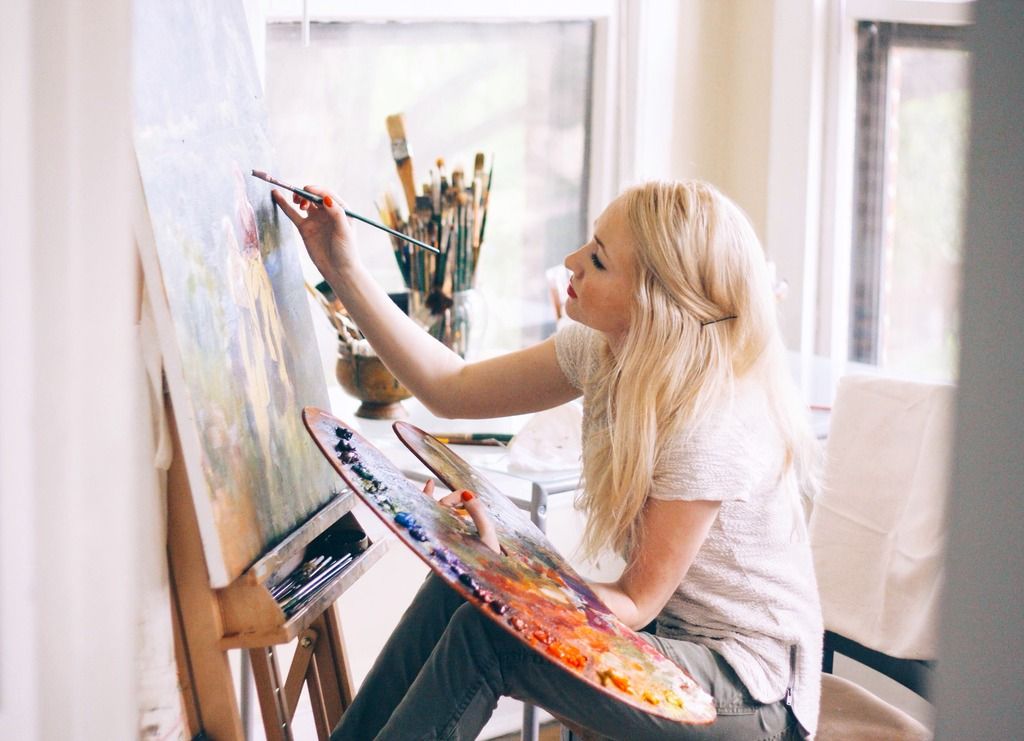A Slow and Thoughtful Way
11:43 AM
In one of my classes we were given the assignment to complete a master copy; in other words, we were given the assignment to copy an exact replica of a "master artist" before the 1900s. Our class is varying from Rembrandt to Teichart (even though she really wasn't a master before the 1900s.) Of course, I chose a favorite: John Singer Sargent. At first I searched his pieces that I know and love, but I wanted something a little bit fresh and a little bit, well, not so "mainstream." I stumbled across his piece Carmela Bertagna.
It was a quick and impulsive, but not so impulsive, decision from there. It was perfect. I have found my style to be tightening up recently (becoming more and more picture perfect realism.) And although I enjoy the process and the growth that it is giving my work, I wanted to dabble back into my lose painting ways again (more of an impressionism feel.)
The second step to this master copy (the first being choosing the piece,) was to do a *quick accurate sketch that could be transferred to the canvas. I figured my proportions, top of head to chin, and quickly set to work with this sketch. I worked for about 45 minutes on this little head study. Noting some changes that could be made more easily with paint rather than a pencil and eraser.
Next, after transfering my image to my canvas and *toning the canvas grey, our task for the day was to complete a value study. This is about an hour into the study. (At 2 hours, my completion time of the value study, I forgot to take another photograph, but I'll post one as soon as possible.) Because of this piece, I learnt something very valuable today: Slow down! Slow down the painting time. Take the time to let it soak. Painting is not racing. It is Painting.
Painting is not racing:
I had to come to this conclusion of "today's painting lesson" with the help of my teacher, Christopher Thornock, that painting is not racing. He actually said the very words, "slow down" to me, but that was just what I needed to hear! Though I didn't feel like it was a race today, I realized that I just was paintingpaintingpainting. Not a second for a breath of air!
I've been at this painting things for some years now, nearing 13 years in fact, and from starting at level 0 at 8 years old I have learnt a great deal of things about painting. (The application of the knowledge has been a much slower process, and still today I think my brain is trying to process some ounce of painting knowledge I "learned" years ago.) However, I've got my system and my ways for painting a decent painting down pat! I can create a decent painting while still keeping all my hair in place, but I always need to remember to slow down and take that "decent" painting to a new level that stretches me. A level that makes me struggle and think. A level that makes me grow and learn. A level that makes them "ooh and ahh." (And for that, a level that makes me "eww and agh" in the process.)
Painting is like making sugar cookies:
Cookies: After you've made them enough times, you know the recipe perfectly.
Painting: After painting enough paintings, you know the exact recipe for what it takes to make a good painting.
Cookies: After mixing all the ingredients together, you can test the result by the texture and or taste of the dough. You know if it's good, and if it is, in fact, good dough, you put it in the oven for the perfect time. "That's pretty good."
Painting: As you apply all your knowledge of painting (the recipe) into the piece, you sense when you've nearly completed a decent painting (the dough.) So you work it a little more, refining things here and there. "That's pretty good."
Cookies: Surely you can eat plain sugar cookies, and if you're recipe is good, that plain sugar cookie, too, is delicious. But doesn't the frosting and ornaments make a sugar cookie a sugar cookie? Spend that time. Frost the cookie. It's so much sweeter in your mouth.
Painting: The frosting of the painting is taking the time to find colors that aren't spot on, or the values that need adjusting, or the lines that could be drawn just a little better. The process to a great painting is a slow and thoughtful way. The frosting is taking the time. If it takes 4 weeks, frost it. It'll be so much sweeter on the wall.
This master copy is schedule to be completed Wednesday, November 7th. Check back for updates.
Notes:
*Transferring a sketch to a canvas is so helpful! Often times, a pencil tip or charcoal tip straight to a canvas can not only be damaging, but also frustrating as texture on texture doesn't allow for detail. My favorite process is to sketch on WindpowerTM smooth Bristol paper, ignoring the size because I can scan it into a computer and print it larger using a program (my favorite for Mac is PosteRazor.) After I complete my sketch, I trace it with tracing paper of any sorts, even wax paper if it's thin enough. Taking the tracing paper with the sketch on it now, I lay it on top of my transfer paper which is atop my canvas and begin my transfer (I prefer Saral Transfer Paper and would rather not scrimp trying to use homemade or anything else.)
*I've worked on a toned canvas and a white canvas both. It depends on the project, but generally I prefer my canvas toned. If i'm worried about losing my transfer, I spray some Fixativ before toning the canvas with diluted Raw Sienna oil paint.










0 Comments